Menu
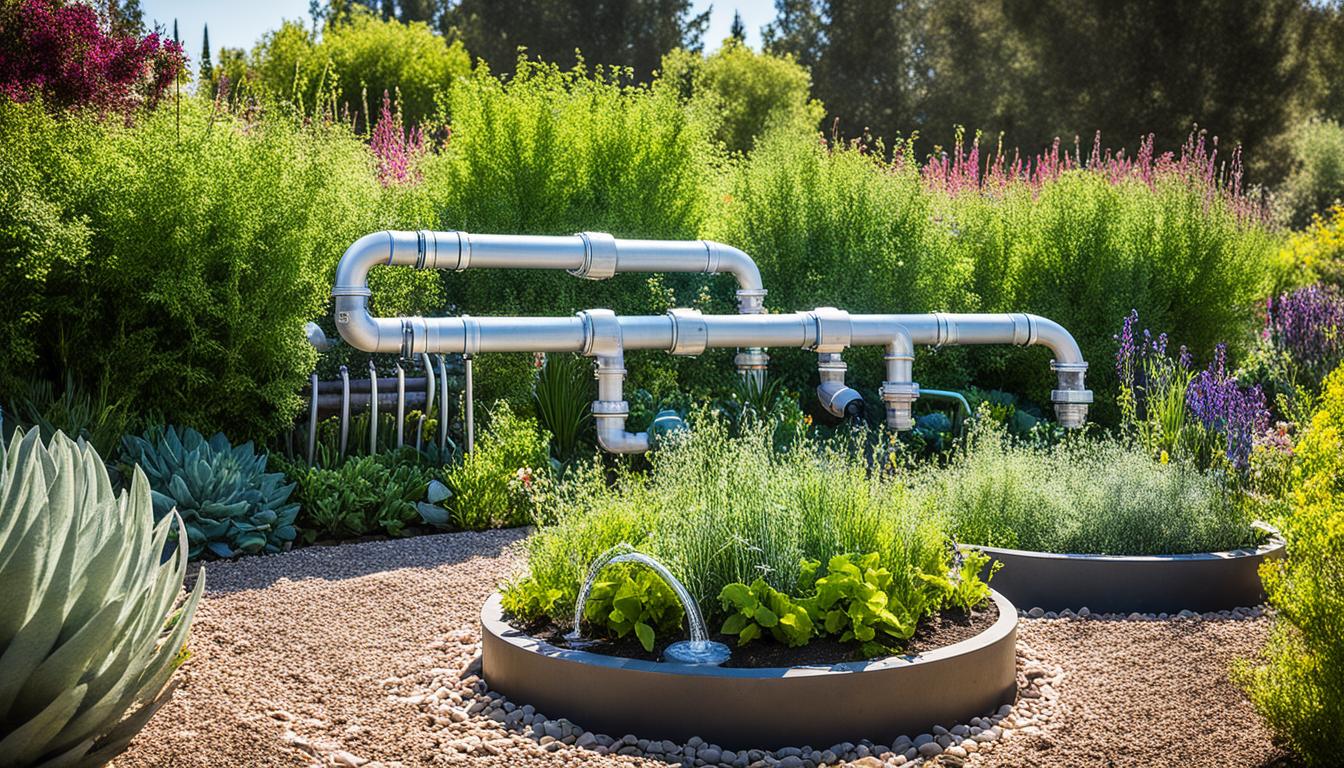
Smart irrigation systems can cut water use by half when compared to old methods. This impressive figure highlights how smart systems are changing the game in saving water. There’s a big demand for these systems, especially after the severe droughts in parts of Germany during 2020.
Beatrice Degenhart, a well-known garden blogger, is leading the way. She’s making her garden project at the spoga+gafa trade fair globally known for its eco-friendliness. By choosing plants that don’t need much water and using high-tech irrigation, like GARDENA’s NatureUp!, she’s on the right track. Rainwater collection is a key part, from classic barrels to modern cisterns made of recycled materials.
The Fiskars Waterwheel XL and Drip Hose make garden watering easier and more direct. They’re not just adding convenience; they’re cutting down the water and effort needed to keep gardens lush and green.
Sustainable irrigation is a big change in how we garden. It’s not just about saving water. It’s about using smart planning and technology. The garden I showcased at spoga+gafa proves that combining the right plants with efficient water systems work best. This method ensures gardens do well, even in places where water is limited. By 2025, this could help half of the world’s people.
Using smart irrigation technology is key. This tech includes advanced sensors for watching water flow, pressure, and quality. They even find and fix leaks. This clever tech makes sure water is used just right. For example, Mottech’s ICC PRO Software puts different sensors together to save water smartly.
Adding IoT and wireless tech to these systems means using less energy. It also means you can control watering from anywhere. This tech combo helps meet goals for saving water and for the environment. It’s all about using water wisely and reducing stress on water sources.
Take systems like GARDENA’s AquaBloom. They and Fiskars Micro-Drip show how automated watering can really work. They get water without needing electricity. This is a big step in tech for saving water. Plus, they keep your plants perfectly watered for a green and healthy garden.
While the start-up costs for smart irrigation can be high, it’s getting easier to afford. New tech and better ways to read data are making these systems cheaper. As more people start using them, our impact on saving water and being green will be huge.
Smart irrigation is a game-changer for saving water in gardens. It uses new tech to help take care of the planet and saves money too.
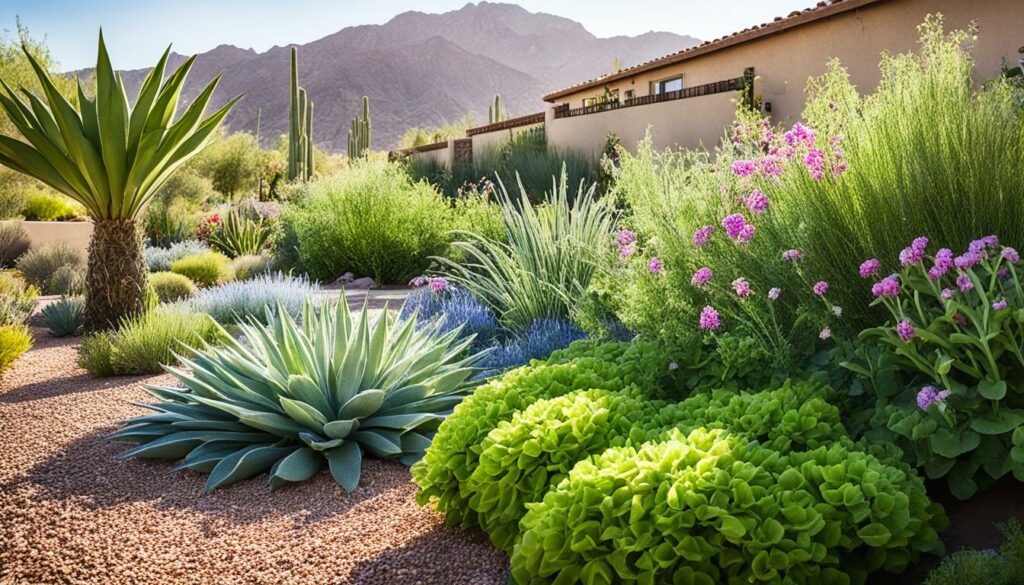
Keeping water safe is key for smart garden setups. The FAO says growing things with water needs takes nearly three-quarters of the world’s water. A system like GARDENA can water very carefully, so water doesn’t just disappear. By using digital smarts, these systems cut down on water use a lot.
They save water by putting it right where plants can drink it. Plus, they know exactly when and how much to water because they check the weather and plant needs. This can save half the water used in a garden. It means less harm to our planet and our pockets.
Smart sprinklers and drips don’t just save water; they save you money too. How? With less water use, the bills go down. Also, you don’t have to fix things as often, which saves even more.
These clever systems let you know exactly how much water you used. They help find leaks early. Plus, they can water your plants when electricity is cheaper. This saves you even more money.
Smart watering keeps your plants joyful by giving them the perfect amount of water. It builds strong roots and keeps diseases away. Plus, it stops plants from getting too much or too little water, which can happen with human watering.
They even change their water plans based on the weather. If it’s rained, they don’t water so much. If it’s really hot, they might water a bit more. This keeps your plants strong and happy.
So, having smart watering in your garden is a big win. It’s great for the planet and for your wallet. Plus, your plants will love you for it.
Efficient irrigation systems are crucial for saving water. Especially, as 80%–90% of our water goes to farming. They cut down on water waste, which is key because the world needs more water.
Drip systems, like the ones Fiskars irrigation solutions offer, are known for their accuracy. They water plants right at the roots. This stops water from evaporating or running off. With drip irrigation, up to 85% of water gets saved, helping gardens and farms grow.
Soaker hoses provide a different but efficient way to water. Brands like Swan make hoses that slowly drip water along their length. This method ensures water goes deep into the soil, helping plants grow strong. Remember, keeping these systems clean is key to their success.
Smart sprinklers are the top level of irrigation tech. They change the watering times based on the weather. For instance, GARDENA’s systems can use 50% less water than usual. By adjusting for different plants and surroundings, they keep water use efficient and plants healthy.
| System Type | Water Savings | Key Features |
|---|---|---|
| Drip Irrigation | Up to 85% | Direct root water delivery, minimizes evaporation |
| Soaker Hose Systems | Significant reduction | Deep soil penetration, enhances root health |
| Smart Sprinkler Systems | Up to 50% | Real-time data adjustments, specific plant needs |
From micro-drip systems to smart sprinklers, these solutions help with water management. They are good for everyone from home gardeners to big farmers. With these, people can use water wisely and help the environment.
Using automated watering is key to better watering in gardens and smart gardening tech. Each day in the United States, people use over 9 billion gallons for the garden. Sadly, half of this water goes to waste because old ways of watering are not efficient.
Automated systems like GARDENA’s Micro-Drip AquaBloom adapt water use to each plant’s needs. They give plants water in the right amounts. This stops plants from getting too much or too little water. Using such tech lowers the amount of wasted water.
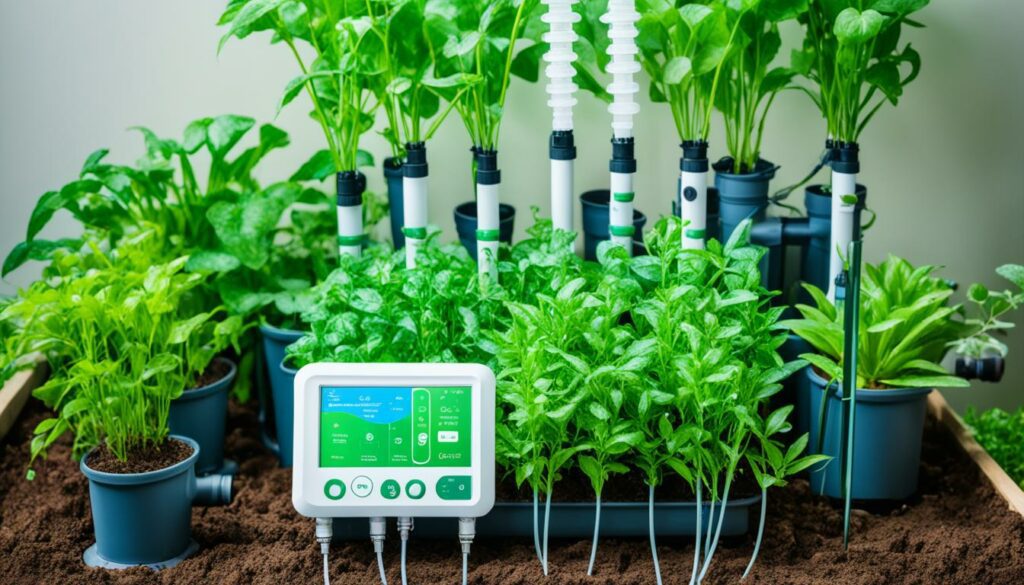
Smart gardening technology is at the heart of this change. For example, smart systems can cut water use by 30% to 50%. In some cases, they save even more water than old systems. The Irrigation Association and the International Center for Water Technology at California State University in Fresno back this claim.
In Washington State’s Puget Sound, using rain sensor controllers saved a lot of water. Places with these smart controllers saved 20,735 gallons a year. In comparison, those with regular controllers saved only 10,071 gallons.
These findings show why smart gardening technology is worth investing in. By automating watering, we save water and make gardens look better. It’s a great way to combine tech and nature for a beautiful, sustainable garden.
When picking the right irrigation system, look closely at your garden’s size and shape. Small gardens do well with simple rainwater collection. For bigger spaces, consider complex setups like cisterns or well systems.
The size and layout of your garden are key garden planning elements. Basic systems work for small areas. Larger spaces might need a lot more, to make sure every plant gets enough water.
Not thinking about size and layout can waste water and increase your bills.
Each plant type has its own water needs. Shrubs and flowers need more water than trees or grass. Drip systems can save water and help plants grow better by watering at the root.
| Plant Type | Water Requirement | Recommended Irrigation |
|---|---|---|
| Shrubs | High | Drip Irrigation |
| Flowers | High | Soaker Hose |
| Trees | Moderate | Emitter Tubing |
| Turf | Low | Sprinkler Systems |
Also, when picking irrigation systems, think about how much rain your area gets. And how often the weather changes. Choosing smart, weather-based watering methods can reduce the effects of changing weather. This keeps your plants just right.
Spending more on advanced systems at the start can save money later. It also makes your garden more friendly to the environment.
Collecting rainwater is a great way to be eco-friendly and save water. Many places like Germany and Australia are already doing it. It’s also becoming popular in America, especially within the green building movement. We’ll look at how to collect rainwater and its benefits for gardens and homes.
There are different ways to collect rainwater, depending on what you need and the space you have. The most used methods are:
Every method needs things like roofs, gutters, and special tanks to collect water. You can add these systems to your home later or when you’re building a new one.
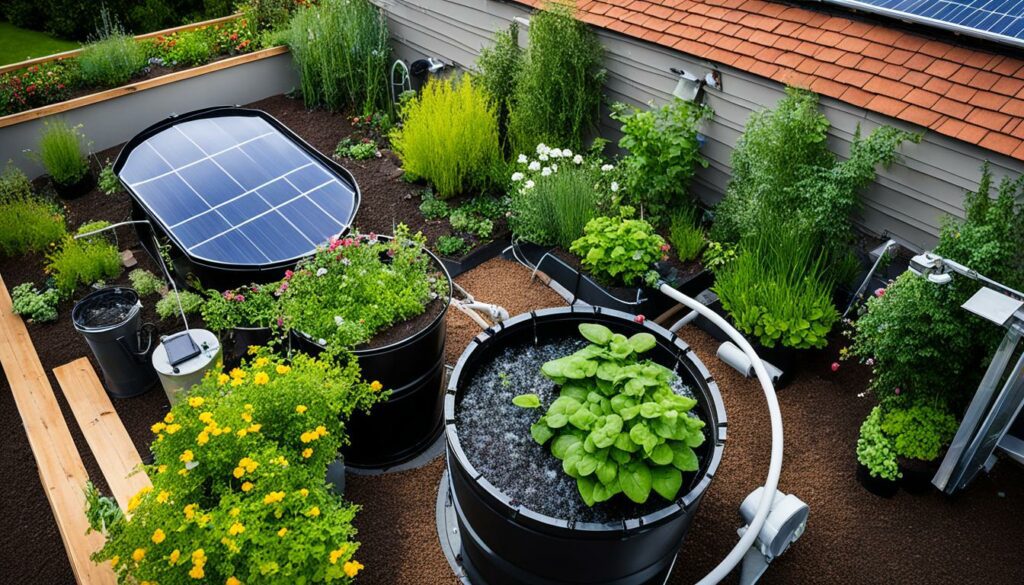
Storing rainwater helps the environment and your wallet. Here’s how:
Also, storing rainwater is good for our community and planet. It’s a helpful backup when there’s not enough rain or an issue with city water.
| Method | Capacity | Main Benefits |
|---|---|---|
| Rain Barrels | 15-10,000 gallons (commonly 50-100 gallons) | Affordable, easy to install, effective for supplementary irrigation |
| Dry Systems | Various, depending on piping and tank size | Direct downspout collection, good for larger scale storage |
| Wet Systems | Varies; typically larger underground tanks | Efficient for multi-source collection, ideal for large properties |
Using rainwater systems is good for saving water and enjoying its benefits. This is a smart way for gardeners and homeowners to help save water.
Adding smart irrigation to your garden is a big step towards modern gardening. By using sensors in systems like GARDENA AquaBloom, the amount of water used is reduced significantly. This happens as the devices check the weather and soil constantly, giving plants exactly the water they need.
Thanks to this tech, gardens can look great without wasting water. In Las Vegas, for example, using smart controllers meant 20% less water was needed. Over in St. Augustine, using this tech on grass saved 43% of water. And, in times of drought, smart soil controllers cut water use by 34%.
Now, let’s look at the costs and savings from these smart tools:
| Controller Type | Cost Range | Water Savings | Benefits |
|---|---|---|---|
| Evapotranspiration Controllers | $250 – $2,500 | 20% – 43% | Reduces water waste, provides precise control |
| Soil Moisture Controllers | $280 – $1,800 | 34% – 72% | Maintains optimal soil moisture, adaptable to drought conditions |
| Rain Sensors | Approx. $25 | Varies | Quick payback, substantial savings during rainfall periods |
Intelligent irrigation through the Internet of Things saves water. These WiFi-connected systems can slash water use by 20% to 40%. They water plants when they really need it, boosting plant health and saving water. This way, your garden can grow well without using too much water, meeting modern eco-goals.
Soil moisture sensors help with soil moisture regulation, giving accurate data on soil wetness. This info guides how we water plants. It stops them getting too much or too little water.
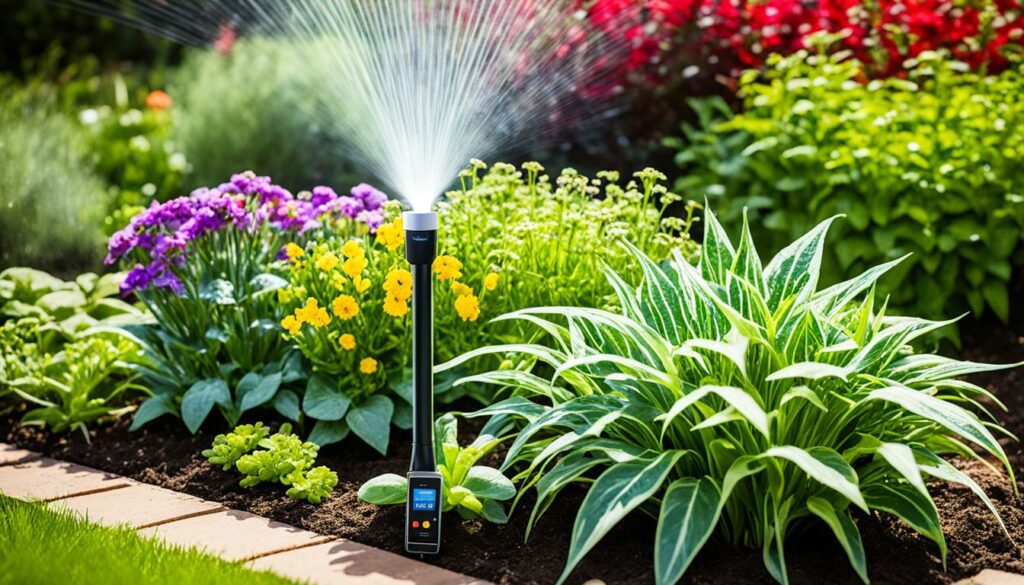
Soil moisture sensors check soil water levels. They use different tech to tell you how much water is in the soil. Neutron probe sensors are very precise but expensive. They cost about $10,000 each. You also need to pay for access tubes and licensing. Tensiometers are cheaper at $80 each. But, they need a lot of looking after. Granular matrix sensors are middle of the road, costing around $40-$50 each. They send their information to data loggers. These can cost between $500 and $3,500.
Volumetric water content (VWC) is key to knowing how much water the soil lacks. This helps water your plants better. By working out VWC and how deep the plant roots go, you can decide how much water is needed. Then, you can water your plants just right.
Soil moisture sensors make watering more efficient. They let you water your plants exactly when needed by checking soil wetness. Sensors like capacitance and TDR give quick and reliable water readings. This works for all soil types and moisture levels. It makes watering smarter and stops plants from getting too dry or too wet.
Tensional readings are also important, especially in sandy soils. They show when plants need water. When these readings are about 25-45 cb, it’s time to water. This keeps crops healthy and not stressed.
| Sensor Type | Cost per Sensor | Maintenance |
|---|---|---|
| Neutron Probe | $10,000 | High |
| Tensiometer | $80 | Frequent |
| Granular Matrix | $40-50 | Moderate |
Using these sensors improves how we water our plants. It helps us make sure they get the right amount of water. This keeps the garden healthy and saves water, too.
Using water-saving irrigation is a key part of good resource management. Water gardens early in the day or late at night to cut losses to the air and water deeper into the soil. This saves money too, as over 80% of the country’s water is used for growing food.
A drip-irrigation system in gardens can save lots of water. It sends water straight to the plant roots. This way, it uses less water and spreads fertilizer better. With timers, you can avoid watering too much and change schedules with the weather.
Another smart way to use water wisely is by collecting rain. You can use barrels or bigger containers to catch and save water. This way, you don’t use as much clean, tap water. It’s a win for the planet and your wallet.
Don’t forget to check your irrigation system often. Make sure sprinklers are aimed right and fix leaks fast. Also, watering when it’s cooler, like early in the morning, stops a lot of water from going to waste.
By using the latest watering methods, gardens can save a lot of water. This is good news for those who grow plants at home and for big farms too. It helps us all step towards a greener, more sustainable future.
| Technique | Benefit | Application |
|---|---|---|
| Early Morning/Night Watering | Minimises evaporative losses | Timely use during cooler parts of the day |
| Drip Irrigation | Reduces water usage, pest problems | Direct water delivery to plant roots |
| Rainwater Collection | Enhances water conservation | Storage in rain barrels, cisterns |
| Reclaimed Water Use | Conserves freshwater resources | For irrigation instead of high-quality freshwater |
| Automatic Timers | Prevents overwatering, optimises schedules | Based on seasonal needs |
Looking after smart irrigation systems is key. It saves water and helps gear last longer. Keep up with regular checks, changes, and quick fixes for leaks.
Doing water system inspections often helps spot small issues early. This can cut down on water by up to 15%. Make sure timers are set right and the pressure is between 40 to 65 for most yards. Also, regular cleanings stop dirt from slowing down your system. This keeps the system working well for longer.
Being watchful for leaks saves water and cash. Leaks are usually in sprinkler heads, drip lines, or connections. Fixing these issues keeps your system running smoothly. Plus, using soil moisture sensors, which cost from $99 to $165, can help catch leaks early.
Keeping your smart irrigation system well-maintained ensures efficient watering. This is vital for eco-friendly gardening.
| Maintenance Task | Frequency | Benefits |
|---|---|---|
| Inspection of timers & sensors | Monthly | Prevents overwatering |
| Leak detection and repairs | Quarterly | Saves water & reduces costs |
| Annual system flush | Annually | Removes debris buildup |
Introducing smart irrigation solutions changes gardening for the better. The spoga+gafa project garden shows how mixing different watering techniques works. They achieve efficient watering, good for the environment and your pocket.

Most of the UK’s water is used in farming. This makes it crucial to farm sustainably as water needs grow. Drip-irrigation, for instance, uses 20% to 60% less water than usual. It also cuts pests and boosts fertiliser power.
Using smart tech, farmers can water their crops just right all year. Rainwater can be collected for garden use. It’s important to keep irrigation systems maintained to save water from leaks and misdirected sprinklers.
The GEAR Lab has made a low-pressure drip system that makes saving energy easy. Their smart approach can bring down costs by 30%. They offer great solutions for saving water.
Soil sensors and AI make watering even more efficient. They give updated data for smarter choices. The GEAR Lab’s system cut water usage by 40% in Morocco compared to the usual way.
In Kenya, Morocco, and Jordan, talking to over 200 experts taught us a lot. This has led to solutions that really fit people’s needs.
So, using smart irrigation is not just good for saving water. It helps make our outdoors greener and more efficient. This mix of tech and know-how is the future of garden care.
Weather-based controllers are at the forefront of smart gardening. They use up-to-the-minute weather data to time watering perfectly. This smart use of tech improves how we water our plants. It’s key in keeping our gardens green while saving water.
These controllers are a big leap in watering tech. By checking local weather, they adjust when to water. This saves loads of water, up to 70% in some cases, compared to old ways. In the US, over 9 billion gallons of water are used outside daily. Sadly, half of it is wasted. But with these controllers, we cut that waste big time.
In Las Vegas, homes saw a 20% drop in water use by switching. This not only saves water but also money. This shows how useful these controllers can be.
Looking to get a weather-based controller? Consider these important features for the best performance:
Adding soil moisture sensors to the mix can really boost a controller’s power. These sensors, which cost between $99 and $165, check the soil’s wetness. They only turn on the water when the soil is really dry. This stops waste and helps plants grow strong.
When we add sprinklers that check if the soil is wet enough before watering, we save even more. These systems know exactly when to stop watering and when to start again.
Weather-based controllers offer lots of great features. They are key in caring for the planet. As we focus more on saving water, these systems will be more and more important.
Seasonal changes greatly impact how much water plants need. So, it’s vital to change how we water them as the seasons shift. Places like Florida, with its wet and dry spells, need special care with seasonal watering adjustments.
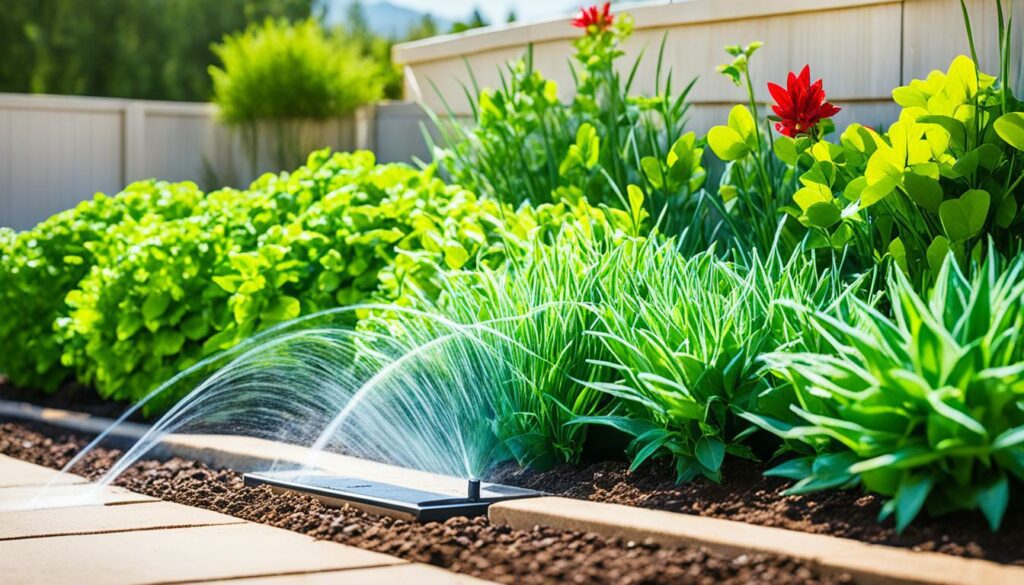
When the wet season comes from June to October, plants need less water. This is because they get more water from rain. In the dry season from November to May, it’s the opposite. Plants need more help to make up for less rain. Using smart technology can make this easier. It changes the watering plan based on the weather and the soil’s moisture.
It’s a good idea to check your sprinklers often, maybe once a month. This keeps them working well. In Florida, it’s the law to have rain sensors on automatic systems. These sensors stop the water when it’s raining. It’s also important to have good drainage. This helps stop areas from getting too wet during the wet season.
In places that get cold, protecting your sprinklers in the winter is a must. Doing smart things like adding mulch in the dry season help keep the soil moist. Talking to experts can help you set up a plan that works for your area and your plants.
Having a good sprinkler system not only saves water but is also better for our planet. These systems adjust the water they give based on what the plants need. Plus, they use real-time information to make smart decisions. Checking the system regularly is a smart move. It helps make sure it’s working as it should.
| Season | Recommended Adjustments |
|---|---|
| Wet Season (June to October) | Reduce watering frequency, ensure proper drainage |
| Dry Season (November to May) | Increase watering frequency, use mulch to retain moisture |
Getting the watering plan right for each season helps plants stay healthy and saves water. Making changes as the weather changes is key. This approach uses the best of climatically intelligent planning.
Water-efficient landscaping means choosing plants that don’t need a lot of water. These plants can survive without much rain. Using mulch around them helps keep the soil moist by stopping water from leaving through evaporation.
It’s key to pick plants that can live through dry times, especially in places like Utah. A big portion of our water goes to keeping plants alive. But sometimes, too much water is given, and the soil isn’t the best.
Plants like sagebrush and yarrow do well with little water once they’re used to their spot. It’s also good to plant them in small groups. It looks nice and, at the same time, uses water smartly.
Adding mulch to your garden is a game-changer for keeping moisture in the soil. It stops water from evaporating too fast. You can use wood chips or bark for mulch. They help the soil hold more water and keep plants healthy.
Good soil is also important for saving water. Eight to twelve inches of topsoil is best for planting. Loamy soil, which has a mix of sand, silt, and clay, is great for plants.
Using smart landscape designs can cut down on how much we need to water the garden. You can start by checking your soil’s needs or visiting gardens that use water wisely. These steps help you make the best choices for your garden and the planet.
The world of smart irrigation is changing fast. New technologies are making it easier to save water. And by 2024, using data to manage farms will be very important, with governments around the world offering support.
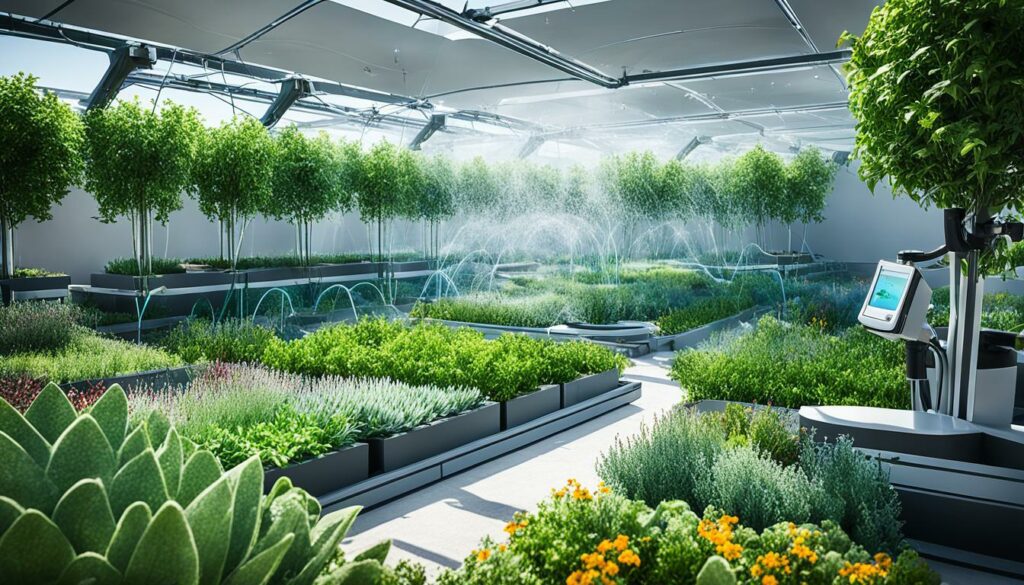
A recent study looked at the top 10 trends in irrigation. It found that things like sensors for plants and soil, using less water with micro-irrigation, and renewable energy for watering are the future. 517 new companies in places like India, Western Europe, and the US are leading the way.
In the US, Innov8.ag is using the internet to plan irrigation smarter. A company from Serbia, IoTartic, is making devices that watch over fields. Israel’s SoliDrip and N-Drip are changing micro-irrigation, using clever valves and gravity. These changes are going to make a big difference in how we manage water for gardens.
Here’s a quick look at what’s big in smart irrigation for next year:
| Trend | Description | Key Example |
|---|---|---|
| Crop and Soil Sensors | Precision irrigation through real-time soil and crop monitoring | Innov8.ag |
| Micro-irrigation | Efficient water use for crops via targeted delivery | SoliDrip |
| Renewables-based Irrigation | Using renewable energy for water management systems | Nimsy Solar Pumps |
| Advanced Water Pumps | Enhanced efficiency in water distribution | N-Drip |
| Smart Irrigation Controllers | Automating irrigation based on real-time data | IoTartic |
| Remote Monitoring | Monitoring irrigation systems remotely for optimisation | Geco Gardens |
| Leak Detection Systems | Identifying and fixing leaks automatically to save water | Innov8.ag |
| Weather Modeling | Adjusting schedules based on weather predictions | IoTartic |
| Soil Modification | Improving soil quality for better water retention | SoliDrip |
| Water Enrichment | Nutrient-enriched irrigation water for improved crop health | N-Drip |
These new technologies, like AI and machine learning, are making gardening more efficient and sustainable. It’s an exciting time for water management.
Using greywater systems in gardens is a big step towards saving water. It lets me reuse water at home, cutting down the amount of water my family uses. This way, I’m helping save water and support green practices in my garden.
Greywater systems take water we’ve used at home and treat it. This treated water then goes to the garden, instead of being wasted. Greywater isn’t as dirty as blackwater, which is why it’s okay to reuse it. But, we must make sure the water is clean enough for the plants by using filters.
I’ve discovered that smart irrigation is key for better water use in gardens. This kind of system uses sensors to know when plants need water. As a result, it reduces water waste by a lot. This is great for our plan to use water wisely and take good care of the earth.
These systems also help plants grow better. They make sure plants get the right amount of water and nutrients. Because of this, gardens are more productive. What’s more, using smart tech in gardening saves work and uses energy well. This cuts energy bills and helps the environment by reducing greenhouse gases.
Smart irrigation systems don’t just save water and money. They also find problems on their own, which cuts maintenance costs. With AI and drones, these systems are super precise. They keep gardens healthy without a lot of effort.
Thanks to smart irrigation, gardening is changing for the better. Now, garden water systems talk to weather and soil sensors. This helps them learn and get even better at saving water. This means we can have beautiful gardens that are good for the earth.
Smart irrigation solutions help save water and money on bills. They ensure plants get just the right amount of water. This is good for the plants and the environment too.
These systems use soil sensors and weather data to water your plants perfectly. They use less water and keep your garden healthy. This is good for using water wisely.
There are drip systems, soaker hoses, and smart sprinklers. Drip systems water plants directly. Soaker hoses keep roots moist. And smart sprinklers water when needed.
Automated systems like GARDENA’s AquaBloom water gardens perfectly. They match water to what your plants need. This saves water and grows healthier plants.
Think about your garden’s size and what plants you have. A small garden might need a rainwater barrel. A big garden might need a cistern. Choose what fits your garden best.
There are simple ways like rain barrels or bigger ones like cisterns. Rainwater is free and helps plants grow well without using up treated water. This is also good for the planet.
Systems that know when plants need water use less and grow healthier. They keep your garden looking good while saving water. It’s a smart way to garden.
Moisture sensors help make sure plants get just the right amount of water. They’re a smart way to avoid wasting water. Your plants will thank you.
Water early or late to avoid sun loss. Drip systems water plants right at the roots. Mulch keeps soil wet. These tricks keep water use low and plants happy.
Check your system often to make sure it’s working correctly. Fix leaks fast. This way, your system will last longer and save more water.
Smart solutions use less water and high-tech sensors. They’re good for the planet and create lush gardens. Just like the project garden at spoga+gafa.
These controllers water your plants only when needed. They use real weather data. This saves water by always watering at the perfect time.
Plants need different amounts of water throughout the year. By watering them right, you save water and keep them healthy. It’s about using water smartly.
Choose plants that don’t need a lot of water. Add mulch to keep the soil moist. These simple steps make your garden green and save water.
New trends include better sensors and apps for watering. Soon, smart systems will even connect with your home. They’ll make watering easier and more efficient.
Greywater recycling is using water from washing to water your garden. It’s good for the planet and saves money. Just make sure the water is safe for your plants.